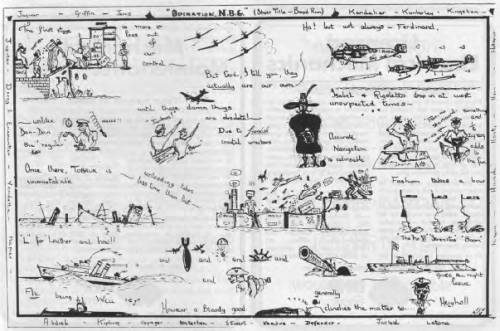- Author
- A.N. Other and NHSA Webmaster
- Subjects
- WWII operations
- Tags
-
- RAN Ships
- HMAS Nizam
- Publication
- September 1990 edition of the Naval Historical Review (all rights reserved)
When Tobruk was captured and later invested, it had been expected that the garrison could be supplied by small ships including ‘A’ lighters (Tank Landing Craft) in convoy from Mersah Matruh or Alexandria.
However the Luftwaffe and submarines thought otherwise and losses became heavy both in cargo carriers and escorts. So another task was added to the lot of destroyers and later, fast minelayers.
The 10th Destroyer Flotilla – Australia V & W Class and RN ‘D’ Class were put into service early in the investment, but were really unable to keep up supplies in sufficient quantity. By August it was realised that they were worn out and should leave the Mediterranean for complete refits elsewhere. It was decided to see if the large destroyers would be satisfactory on the run from Alexandria to Tobruk and return, as opposed to the smaller destroyers run from Mersah Matruh to Tobruk and return. Nizam of which I was First Lieutenant was the first large destroyer to do the run and Captain Stephen Arliss (D7) embarked to assess the operation. He decided it could be done and so began a period in which Nizam made 14 runs including the last during the siege.
The runs developed into quite a routine, Day 1 alongside 38 Quay for loading cargo, mostly ammunition, gun barrels and mail – I always took 90 bags. Day 2, embark troops and depart early forenoon, speed about 25 knots until just after dark, increase to 30 knots, arrive Tobruk about 2330, berth on a wreck, unload troops and cargo, embark wounded soldiers, some on stretchers – then other soldiers, leave Tobruk, speed 30 knots reducing after dawn and arriving Alexandria in the afternoon, berth at No. 38 Quay and disembark personnel. Incidentally I have yet to see Tobruk in daylight.
But of course the runs did have their moments and some of the regular ones are portrayed on the attached photo of a sketch.

Nizam herself had some outstanding incidents which I think are worth re-telling.
(a) We were on our way and were attacked in the late afternoon by three Italian torpedo bombers. We turned away from the tracks and one tin fish went up the port side, one up the starboard and the third blew up in our wake just astern. Our 4 inch barrage gun which I controlled had fired many rounds and the barrel was worn, but I saw one shell wobble its way out and pass just under the plane. I’ve always wondered what sort of explosion would have occurred had the torpedo been hit.
(b) One night a strong puff of wind pushed us on to the wreck just as we were berthing. Loud screeches and noise of tearing metal on forecastle and ship’s side. But fortunately little water came in as we worked up speed to go ‘home’ and the weather remained kind.
(c) One morning just before dawn our very primitive RDF (RADAR) set picked up an echo. Being a set designed for aircraft it was fixed and the aircraft was supposed to alter course to find out the bearing. Asked ‘where?’ the reply came back ‘I think starboard’. Just at that moment the aircraft, JU88, was seen fine on the starboard bow, diving, and close. The wheel was put over immediately but a bomb went off close amidships, the resulting shock bringing us to a halt. We were taken in tow but fortunately the engineer officer got us going again on one engine and we limped back without further incident. The aircraft probably needed repair too, as our RDF aerial was bent right over, so close had it been to us.
(d) Nizam was also included in the last supply run before the ‘breakout’. Normally the destroyers only made the run in the moonless period but we were told that ammunition was running low and we were to take as much as possible up. It was just on full moon and therefore could be a dicey run. We loaded some 1 million rounds of small arms ammunition and some larger, and departed Alexandria at night. One can imagine what sort of fireworks display there would have been had a cannon shell hit one of the cases which had very rickety lids.




